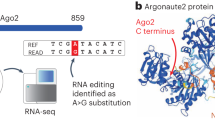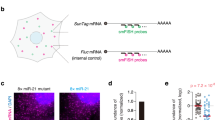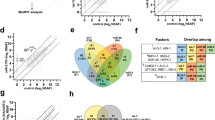Abstract
MicroRNAs (miRNAs) are a class of noncoding RNAs that post-transcriptionally regulate gene expression in plants and animals1,2. To investigate the influence of miRNAs on transcript levels, we transfected miRNAs into human cells and used microarrays to examine changes in the messenger RNA profile. Here we show that delivering miR-124 causes the expression profile to shift towards that of brain, the organ in which miR-124 is preferentially expressed, whereas delivering miR-1 shifts the profile towards that of muscle, where miR-1 is preferentially expressed. In each case, about 100 messages were downregulated after 12 h. The 3′ untranslated regions of these messages had a significant propensity to pair to the 5′ region of the miRNA, as expected if many of these messages are the direct targets of the miRNAs3. Our results suggest that metazoan miRNAs can reduce the levels of many of their target transcripts, not just the amount of protein deriving from these transcripts. Moreover, miR-1 and miR-124, and presumably other tissue-specific miRNAs, seem to downregulate a far greater number of targets than previously appreciated, thereby helping to define tissue-specific gene expression in humans.
This is a preview of subscription content, access via your institution
Access options
Subscribe to this journal
Receive 51 print issues and online access
$199.00 per year
only $3.90 per issue
Buy this article
- Purchase on Springer Link
- Instant access to full article PDF
Prices may be subject to local taxes which are calculated during checkout




Similar content being viewed by others
References
Bartel, D. P. MicroRNAs: genomics, biogenesis, mechanism, and function. Cell 116, 281–297 (2004)
Carrington, J. C. & Ambros, V. Role of microRNAs in plant and animal development. Science 301, 336–338 (2003)
Lewis, B. P., Shih, I. H., Jones-Rhoades, M. W., Bartel, D. P. & Burge, C. B. Prediction of mammalian microRNA targets. Cell 115, 787–798 (2003)
Palatnik, J. F. et al. Control of leaf morphogenesis by microRNAs. Nature 425, 257–263 (2003)
Jackson, A. L. et al. Expression profiling reveals off-target gene regulation by RNAi. Nature Biotechnol. 21, 635–637 (2003)
Hutvagner, G. & Zamore, P. D. A microRNA in a multiple-turnover RNAi enzyme complex. Science 297, 2056–2060 (2002)
Zeng, Y., Yi, R. & Cullen, B. R. MicroRNAs and small interfering RNAs can inhibit mRNA expression by similar mechanisms. Proc. Natl Acad. Sci. USA 100, 9779–9784 (2003)
Doench, J. G., Petersen, C. P. & Sharp, P. A. siRNAs can function as miRNAs. Genes Dev. 17, 438–442 (2003)
Yekta, S., Shih, I. H. & Bartel, D. P. MicroRNA-directed cleavage of HOXB8 mRNA. Science 304, 594–596 (2004)
Lagos-Quintana, M. et al. Identification of tissue-specific microRNAs from mouse. Curr. Biol. 12, 735–739 (2002)
Sempere, L. F. et al. Expression profiling of mammalian microRNAs uncovers a subset of brain-expressed microRNAs with possible roles in murine and human neuronal differentiation. Genome Biol. 5, R13 (2004)
Pruitt, K. D. & Maglott, D. R. RefSeq and LocusLink: NCBI gene-centered resources. Nucleic Acids Res. 29, 137–140 (2001)
Johnson, J. M. et al. Genome-wide survey of human alternative pre-mRNA splicing with exon junction microarrays. Science 302, 2141–2144 (2003)
Bailey, T. L. & Elkan, C. Fitting a mixture model by expectation maximization to discover motifs in biopolymers. Proc. Int. Conf. Intell. Syst. Mol. Biol. 2, 28–36 (1994)
Lim, L. P. et al. The microRNAs of Caenorhabditis elegans . Genes Dev. 17, 991–1008 (2003)
Wightman, B., Ha, I. & Ruvkun, G. Posttranscriptional regulation of the heterochronic gene lin-14 by lin-4 mediates temporal pattern formation in C. elegans . Cell 75, 855–862 (1993)
Lai, E. C. Micro RNAs are complementary to 3′ UTR sequence motifs that mediate negative post-transcriptional regulation. Nature Genet. 30, 363–364 (2002)
Doench, J. G. & Sharp, P. A. Specificity of microRNA target selection in translational repression. Genes Dev. 18, 504–511 (2004)
John, B. et al. Human MicroRNA targets. PLoS Biol. 2, e363 (2004)
Rhoades, M. W. et al. Prediction of plant microRNA targets. Cell 110, 513–520 (2002)
Haley, B. & Zamore, P. D. Kinetic analysis of the RNAi enzyme complex. Nature Struct. Mol. Biol. 11, 599–606 (2004)
Martinez, J. & Tuschl, T. RISC is a 5′ phosphomonoester-producing RNA endonuclease. Genes Dev. 18, 975–980 (2004)
Janz, R. & Sudhof, T. C. Cellugyrin, a novel ubiquitous form of synaptogyrin that is phosphorylated by pp60c-src. J. Biol. Chem. 273, 2851–2857 (1998)
Vartiainen, M. K., Sarkkinen, E. M., Matilainen, T., Salminen, M. & Lappalainen, P. Mammals have two twinfilin isoforms whose subcellular localizations and tissue distributions are differentially regulated. J. Biol. Chem. 278, 34347–34355 (2003)
Bartel, D. P. & Chen, C. Z. Micromanagers of gene expression: the potentially widespread influence of metazoan microRNAs. Nature Rev. Genet. 5, 396–400 (2004)
Ashburner, M. et al. Gene ontology: tool for the unification of biology. The Gene Ontology Consortium. Nature Genet. 25, 25–29 (2000)
Schwarz, D. S. et al. Asymmetry in the assembly of the RNAi enzyme complex. Cell 115, 199–208 (2003)
Khvorova, A., Reynolds, A. & Jayasena, S. D. Functional siRNAs and miRNAs exhibit strand bias. Cell 115, 209–216 (2003)
Hughes, T. R. et al. Functional discovery via a compendium of expression profiles. Cell 102, 109–126 (2000)
Thompson, J. D., Higgins, D. G. & Gibson, T. J. CLUSTAL W: improving the sensitivity of progressive multiple sequence alignment through sequence weighting, position-specific gap penalties and weight matrix choice. Nucleic Acids Res. 22, 4673–4680 (1994)
Acknowledgements
Thanks to S. Baskerville, M. Cleary and P. Sharp for comments on the manuscript, C. Armour, S. Bartz, J. Burchard, G. Cavet, D. Haynor, A. Jackson, M. Pellegrini, E. Schadt and Y. Wang for their assistance, the Rosetta Gene Expression Laboratory for microarray work, M. Jones-Rhoades for primer design, and W. Johnston for plasmid construction.
Author information
Authors and Affiliations
Corresponding author
Ethics declarations
Competing interests
The authors declare that they have no competing financial interests.
Supplementary information
Supplementary Discussion
Analysis of overlaps with computational predictions. (DOC 45 kb)
Supplementary Note
Sequences cloned into reporter vectors. (DOC 53 kb)
Supplementary Figure 1
Quantitative northern blot analysis of miR-1 and miR-124 expression. (PDF 359 kb)
Supplementary Figure 2
Tissue analysis for mutant microRNAs. (PDF 28 kb)
Supplementary Figure 3
Expected and observed seed match counts in different regions of miR-1 or miR-124 downregulated genes. (PDF 8 kb)
Supplementary Figure 4
p-values of enrichment for hexamers complementary to miR-124 in the 3' UTRs of the miR-124 downregulated genes. (PDF 8 kb)
Supplementary Figure 5
Motif and tissue analysis for miR-373. (PDF 43 kb)
Supplementary Table 1
Genes downregulated by miR-1 at a p-value < 0.001 at both 12 and 24 h. (DOC 209 kb)
Supplementary Table 2
Genes downregulated by miR-124 at a p-value < 0.001 at both 12 and 24 h. (DOC 342 kb)
Supplementary Table 3
Hexamers enriched in the 3' UTRs of the downregulated sets. (DOC 52 kb)
Supplementary Table 4
Genes downregulated by miR-373 at a p-value < 0.001 at both 12 and 24 h. (DOC 155 kb)
Supplementary Methods
This file contains MIAME (Minimum Information About a Microarray Experiment) methods data. (DOC 44 kb)
Rights and permissions
About this article
Cite this article
Lim, L., Lau, N., Garrett-Engele, P. et al. Microarray analysis shows that some microRNAs downregulate large numbers of target mRNAs. Nature 433, 769–773 (2005). https://doi.org/10.1038/nature03315
Received:
Accepted:
Published:
Issue Date:
DOI: https://doi.org/10.1038/nature03315
This article is cited by
-
Genome-scale pan-cancer interrogation of lncRNA dependencies using CasRx
Nature Methods (2024)
-
MicroRNAs and Cardiovascular Disease Risk
Current Cardiology Reports (2024)
-
miRNAs in pancreatic cancer progression and metastasis
Clinical & Experimental Metastasis (2024)
-
Oligonucleotide therapeutics and their chemical modification strategies for clinical applications
Journal of Pharmaceutical Investigation (2024)
-
The dual role of microRNA (miR)-20b in cancers: Friend or foe?
Cell Communication and Signaling (2023)
Comments
By submitting a comment you agree to abide by our Terms and Community Guidelines. If you find something abusive or that does not comply with our terms or guidelines please flag it as inappropriate.



